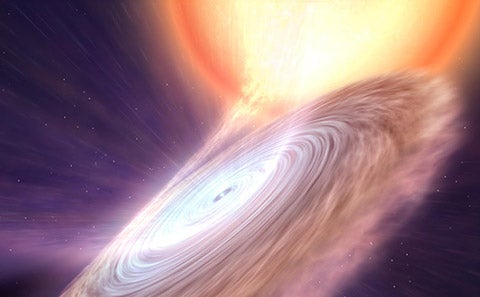Scientists find the lightest neutron star ever – and it is incredibly ‘strange’
The lightest neutron star yet found could pove to be an exotic form of matter — and will teach scientists a thing or two either way

Your support helps us to tell the story
From reproductive rights to climate change to Big Tech, The Independent is on the ground when the story is developing. Whether it's investigating the financials of Elon Musk's pro-Trump PAC or producing our latest documentary, 'The A Word', which shines a light on the American women fighting for reproductive rights, we know how important it is to parse out the facts from the messaging.
At such a critical moment in US history, we need reporters on the ground. Your donation allows us to keep sending journalists to speak to both sides of the story.
The Independent is trusted by Americans across the entire political spectrum. And unlike many other quality news outlets, we choose not to lock Americans out of our reporting and analysis with paywalls. We believe quality journalism should be available to everyone, paid for by those who can afford it.
Your support makes all the difference.Scientists have discovered the lightest Neutron star ever, a small, extremely dense stellar object that might also confirm the existence of a very strange state of matter.
Neutron stars are one of the potential outcomes when a massive star dies in a fiery supernova explosion. After blowing off most of its mass in the explosion, the remaining stellar core collapses in on itself, forming either a black hole, or a neutron star, an ultra-compact star usually about 1.4 times as massive as the Sun, but only around six miles in diameter.
But scientists measuring the mass of a neutron star found in remnants of a past supernova called HESS J1731-347 found the neutron star weighed in at 77% the mass of the Sun, according to their paper published Monday in the journal Nature Astronomy. It’s not only the light neutron star yet discovered, the authors note, but could be an example of an exotic and so far only hypothetical stellar object known as a “strange star.”
Strange stars live up to their names both colloquially and theoretically.
When they form out of the collapsing core of a massive and dying star, neutron stars are believed to become so compressed that the normally charged constituents of matter, the positively charged protons in the atomic nuclei and the negatively charged electrons orbiting each atom’s nucleus, are crushed together into negatively charged neutron particles.
But it’s theorized that under the right conditions, the interiors of neutron stars could get even weirder.
It’s theorized that the matter deep in a neutron star could be squeezed until the usual subatomic particles such as neutrons no longer exists, and matter exists in the form of the even smaller particles, known as quarks, that make up the more familiar protons and neutrons. Quarks come with strange names, such as up, down, top, charmed, and in fact, “strange.”
A neutron star with a core of quark matter containing strange quarks would be considered a “strange star,” and would theoretically have lower mass than a conventional neutron star.
It’s not clear just yet what astronomers are dealing with, and they could likely learn a great deal from studying the object whether it turns out to be a conventional neutron star or a “strange star.”
“Our estimate implies that this object is either the lightest neutron star known, or a ‘strange star’ with a more exotic equation of state,” they write. Adopting a standard neutron star matter hypothesis allows the corresponding equations of state to be constrained.”
Join our commenting forum
Join thought-provoking conversations, follow other Independent readers and see their replies
Comments